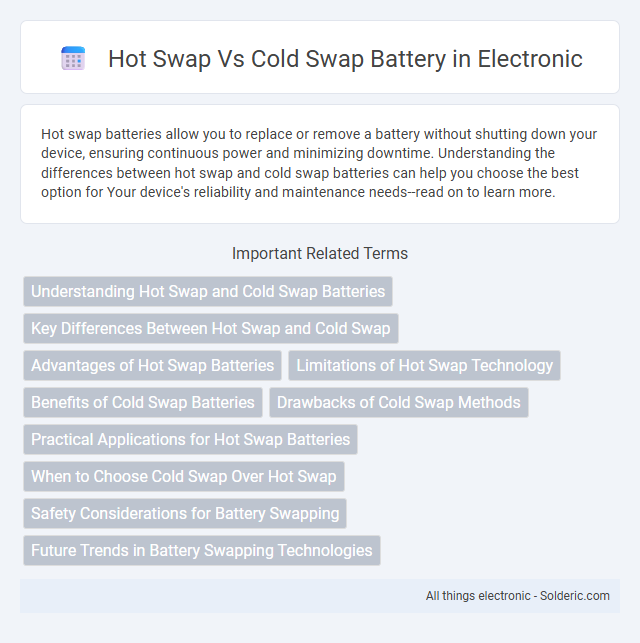Hot swap batteries allow you to replace or remove a battery without shutting down your device, ensuring continuous power and minimizing downtime. Understanding the differences between hot swap and cold swap batteries can help you choose the best option for Your device's reliability and maintenance needs--read on to learn more.
Comparison Table
| Feature | Hot Swap Battery | Cold Swap Battery |
|---|---|---|
| Definition | Replacing or exchanging a battery without shutting down the device | Replacing a battery after powering off the device |
| Device Downtime | No downtime, continuous operation | Device is offline during battery replacement |
| Use Case | Servers, data centers, critical systems needing 24/7 uptime | Non-critical devices, scenarios where brief downtime is acceptable |
| Technical Requirement | Supports hot-swapping circuitry and connectors | Standard battery connectors, no special hardware |
| Risk of Data Loss | Minimal to none if properly implemented | Possible if system was not properly shut down |
| Complexity | Higher due to hardware/software integration | Lower, simpler process |
| Cost | Higher initial investment due to specialized hardware | Lower cost with standard hardware |
Understanding Hot Swap and Cold Swap Batteries
Hot swap batteries allow you to replace or remove the battery from a device without powering it down, ensuring continuous operation and minimizing downtime. Cold swap batteries require the device to be completely powered off before battery replacement, which can interrupt usage but may be simpler and safer for certain hardware. Choosing the right swap method depends on your device's design and operational needs, ensuring optimal performance and reliability.
Key Differences Between Hot Swap and Cold Swap
Hot swap batteries can be replaced or installed without powering down the device, ensuring continuous operation and minimizing downtime. Cold swap batteries require the device to be completely powered off before removal or installation, preventing potential electrical damage but causing operational interruption. The key difference lies in hot swap's ability to maintain device functionality during battery changes, while cold swap necessitates shutdown for safety and hardware protection.
Advantages of Hot Swap Batteries
Hot swap batteries allow for seamless replacement without powering down the device, ensuring continuous operation and minimizing downtime in critical applications. This technology enhances productivity and system reliability, particularly in data centers, medical equipment, and industrial machinery. Hot swap batteries also reduce wear on connectors and prolong device lifespan by avoiding repeated power cycling.
Limitations of Hot Swap Technology
Hot swap technology allows battery replacement without powering down the device, enhancing uptime in critical systems such as servers and medical equipment. However, limitations include complex circuitry requirements to manage power surges and prevent data corruption, alongside increased costs and potential hardware compatibility issues. Furthermore, safety concerns arise from improper handling during hot swaps, which can lead to electrical hazards or damage to the battery and device components.
Benefits of Cold Swap Batteries
Cold swap batteries offer enhanced safety by allowing you to replace or change batteries without powering down the device, minimizing disruption to operations. They reduce wear and tear on the electrical components, extending device lifespan and improving reliability. This approach is ideal for critical systems where continuous power is essential, ensuring seamless performance without downtime.
Drawbacks of Cold Swap Methods
Cold swap battery methods entail powering down the device completely before replacing the battery, which leads to significant downtime and potential disruption of your workflow. This approach increases the risk of data loss and hardware wear due to frequent power cycles. Moreover, cold swapping is less efficient in critical applications where continuous operation and uptime are essential.
Practical Applications for Hot Swap Batteries
Hot swap batteries are widely used in data centers, medical devices, and telecommunications systems where continuous power supply is crucial because they allow battery replacement without shutting down the equipment. This functionality minimizes downtime and enhances operational efficiency, ensuring that your critical devices remain powered even during maintenance. In contrast, cold swap batteries require the system to be powered off before replacement, making hot swap solutions preferable for mission-critical applications.
When to Choose Cold Swap Over Hot Swap
Cold swap batteries are ideal when complete power shutdown is necessary to ensure safety or prevent data corruption, such as during hardware upgrades or system maintenance. You should choose cold swap over hot swap in environments where the risk of electrical shocks, damage to components, or data loss outweighs the need for continuous operation. This method is crucial in sensitive electronics or critical systems where uninterrupted power may not be feasible or safe.
Safety Considerations for Battery Swapping
Hot swap battery changes require careful safety measures to manage live electrical currents and prevent short circuits, making insulated tools and proper grounding essential. Cold swap batteries are safer since the device is powered off, minimizing the risk of electric shock and data corruption during replacement. Ensuring your battery replacement follows strict safety protocols protects both the equipment and your personal well-being.
Future Trends in Battery Swapping Technologies
Future trends in battery swapping technologies focus on enhancing hot swap systems that allow seamless, real-time battery replacements without powering down devices, significantly reducing downtime in electric vehicles and portable electronics. Innovations in modular battery packs and standardized interfaces aim to expand compatibility and accelerate the adoption of battery swapping networks worldwide. Advances in AI and IoT integration optimize battery health monitoring and swapping logistics, driving efficiency and sustainability in energy storage solutions.
Hot swap vs cold swap battery Infographic

 solderic.com
solderic.com